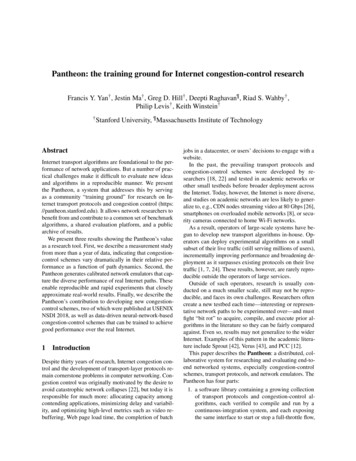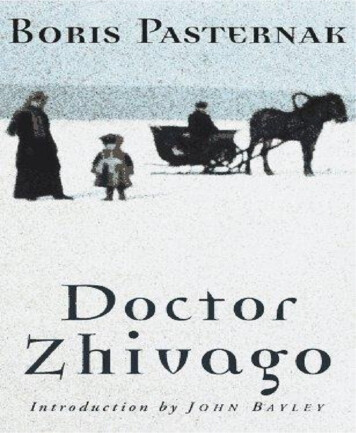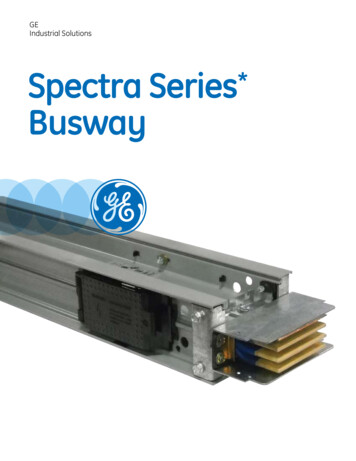
Transcription
Pantheon: the training ground for Internet congestion-control researchFrancis Y. Yan† , Jestin Ma† , Greg D. Hill† , Deepti Raghavan¶ , Riad S. Wahby† ,Philip Levis† , Keith Winstein†† StanfordUniversity, ¶ Massachusetts Institute of TechnologyAbstractInternet transport algorithms are foundational to the performance of network applications. But a number of practical challenges make it difficult to evaluate new ideasand algorithms in a reproducible manner. We presentthe Pantheon, a system that addresses this by servingas a community “training ground” for research on Internet transport protocols and congestion control (https://pantheon.stanford.edu). It allows network researchers tobenefit from and contribute to a common set of benchmarkalgorithms, a shared evaluation platform, and a publicarchive of results.We present three results showing the Pantheon’s valueas a research tool. First, we describe a measurement studyfrom more than a year of data, indicating that congestioncontrol schemes vary dramatically in their relative performance as a function of path dynamics. Second, thePantheon generates calibrated network emulators that capture the diverse performance of real Internet paths. Theseenable reproducible and rapid experiments that closelyapproximate real-world results. Finally, we describe thePantheon’s contribution to developing new congestioncontrol schemes, two of which were published at USENIXNSDI 2018, as well as data-driven neural-network-basedcongestion-control schemes that can be trained to achievegood performance over the real Internet.1IntroductionDespite thirty years of research, Internet congestion control and the development of transport-layer protocols remain cornerstone problems in computer networking. Congestion control was originally motivated by the desire toavoid catastrophic network collapses [22], but today it isresponsible for much more: allocating capacity amongcontending applications, minimizing delay and variability, and optimizing high-level metrics such as video rebuffering, Web page load time, the completion of batchjobs in a datacenter, or users’ decisions to engage with awebsite.In the past, the prevailing transport protocols andcongestion-control schemes were developed by researchers [18, 22] and tested in academic networks orother small testbeds before broader deployment acrossthe Internet. Today, however, the Internet is more diverse,and studies on academic networks are less likely to generalize to, e.g., CDN nodes streaming video at 80 Gbps [26],smartphones on overloaded mobile networks [8], or security cameras connected to home Wi-Fi networks.As a result, operators of large-scale systems have begun to develop new transport algorithms in-house. Operators can deploy experimental algorithms on a smallsubset of their live traffic (still serving millions of users),incrementally improving performance and broadening deployment as it surpasses existing protocols on their livetraffic [1, 7, 24]. These results, however, are rarely reproducible outside the operators of large services.Outside of such operators, research is usually conducted on a much smaller scale, still may not be reproducible, and faces its own challenges. Researchers oftencreate a new testbed each time—interesting or representative network paths to be experimented over—and mustfight “bit rot” to acquire, compile, and execute prior algorithms in the literature so they can be fairly comparedagainst. Even so, results may not generalize to the widerInternet. Examples of this pattern in the academic literature include Sprout [42], Verus [43], and PCC [12].This paper describes the Pantheon: a distributed, collaborative system for researching and evaluating end-toend networked systems, especially congestion-controlschemes, transport protocols, and network emulators. ThePantheon has four parts:1. a software library containing a growing collectionof transport protocols and congestion-control algorithms, each verified to compile and run by acontinuous-integration system, and each exposingthe same interface to start or stop a full-throttle flow,
2. a diverse testbed of network nodes on wireless andwired networks around the world, including cellularnetworks in Stanford (U.S.), Guadalajara (Mexico),São Paulo (Brazil), Bogotá (Colombia), New Delhi(India), and Beijing (China), and wired networks inall of the above locations as well as London (U.K.),Iowa (U.S.), Tokyo (Japan), and Sydney (Australia),size, stochastic per-packet loss rate, and propagationdelay) is sufficient to replicate the performance ofa diverse library of transport protocols (with eachprotocol matching its real-world throughput and delay to within 17% on average), in the presence ofboth natural and synthetic cross traffic. These resultsgo against some strains of thought in computer networking, which have focused on building detailednetwork emulators (with mechanisms to model jitter,reordering, the arrival and departure of cross traffic,MAC dynamics, etc.), while leaving the questionsopen of how to configure an emulator to accuratelymodel real networks and how to quantify the emulator’s overall fidelity to a target (§5).3. a collection of network emulators, each calibratedto match the performance of a real network path between two nodes, or to capture some form of pathological network behavior, and4. a continuous-testing system that regularly evaluatesthe Pantheon protocols over the real Internet betweenpairs of testbed nodes, across partly-wireless and allwired network paths, and over each of the networkemulators, in single- and multi-flow scenarios, andpublicly archives the resulting packet traces and analyses at https://pantheon.stanford.edu.The Pantheon’s calibrated network emulators addressa tension that protocol designers face between experimental realism and reproducibility. Simulators and emulators are reproducible and allow rapid experimentation,but may fail to capture important dynamics of real networks [15, 16, 31]. To resolve this tension, the Pantheongenerates network emulators calibrated to match real Internet paths, graded by a novel figure of merit: their accuracyin matching the performance of a set of transport algorithms. Rather than focus on the presence or absence ofmodeled phenomena (jitter, packet loss, reordering), thismetric describes how well the end-to-end performance(e.g., throughput, delay, and loss rate) of a set of algorithms, run over the emulated network, matches the corresponding performance statistics of the same algorithmsrun over a real network path.Motivated by the success of ImageNet [11, 17] in thecomputer-vision community, we believe a common reference set of runnable benchmarks, continuous experimentation and improvement, and a public archive of results willenable faster innovation and more effective, reproducibleresearch. Early adoption by independent research groupsprovides encouraging evidence that this is succeeding.Summary of results: Examining more than a year of measurements fromthe Pantheon, we find that transport performance ishighly variable across the type of network path, bottleneck network, and time. There is no single existingprotocol that performs well in all settings. Furthermore, many protocols perform differently from howtheir creators intended and documented (§4). We find that a small number of network-emulator parameters (bottleneck link rate, isochronous or memoryless packet inter-arrival timing, bottleneck buffer We discuss three new approaches to congestion control that are using the Pantheon as a shared evaluationtestbed, giving us encouragement that it will proveuseful as a community resource. Two are from research groups distinct from the present authors, andwere published at USENIX NSDI 2018: Copa [2]and Vivace [13]. We also describe our own datadriven designs for congestion control, based on neural networks that can be trained on a collection ofthe Pantheon’s emulators and in turn achieve goodperformance over real Internet paths (§6).2Related workPantheon benefits from a decades-long body of relatedwork in Internet measurement, network emulation, transport protocols, and congestion-control schemes.Tools for Internet measurement. Systems like PlanetLab [10], Emulab [40], and ORBIT [30] provide measurement nodes for researchers to test transport protocols andother end-to-end applications. PlanetLab, which was inwide use from 2004–2012, at its peak included hundredsof nodes, largely on well-provisioned (wired) academicnetworks around the world. Emulab allows researchers torun experiments over configurable network emulators andon Wi-Fi links within an office building.While these systems are focused on allowing researchers to borrow nodes and run their own tests, thePantheon operates at a higher level of abstraction. Pantheon includes a single community software package thatresearchers can contribute algorithms to. Anybody canrun any of the algorithms in this package, including overEmulab or any network path, but Pantheon also hosts acommon repository of test results (including raw packettraces) of scripted comparative tests.Network emulation. Congestion-control research haslong used network simulators, e.g., ns-2 [28], as wellas real-time emulators such as Dummynet [6, 33],NetEm [20], Mininet [19], and Mahimahi [27].
These emulators provide increasing numbers of parameters and mechanisms to recreate different networkbehaviors, such as traffic shapers, policers, queue disciplines, stochastic i.i.d. or autocorrelated loss, reordering,bit errors, and MAC dynamics. However, properly settingthese parameters to emulate a particular target networkremains an open problem.One line of work has focused on improving emulatorprecision in terms of the level of detail and fidelity atmodeling small-scale effects (e.g., “Two aspects influencethe accuracy of an emulator: how detailed is the model ofthe system, and how closely the hardware and softwarecan reproduce the timing computed by the model” [6]).Pantheon takes a different approach, instead focusing onaccuracy in terms of how well an emulator recreates theperformance of a set of transport algorithms.Congestion control. Internet congestion control has adeep literature. The original DECBit [32] and Tahoe [22]algorithms responded to one-bit feedback from the network, increasing and decreasing a congestion window inresponse to acknowledgments and losses. More recently,researchers have tried to formalize the protocol-designprocess by generating a congestion-control scheme as afunction of an objective function and prior beliefs aboutthe network and workload. Remy [37, 41] and PCC [12]are different kinds of “learned” schemes [35]. Remy usesan offline optimizer that generates a decision tree to optimize a global utility score based on network simulations.PCC uses an online optimizer that adapts its sending rateto maximize a local utility score in response to packetlosses and RTT samples. In our current work (§ 6), weask whether it is possible to quickly train an algorithmfrom first principles to produce good global performanceon real Internet paths.3Design and implementationThis section describes the design and implementation ofthe Pantheon, a system that automatically measures theperformance of many transport protocols and congestioncontrol schemes across a diverse set of network paths. Byallowing the community to repeatably evaluate transportalgorithms in scripted comparative tests across real-worldnetwork paths, posted to a public archive of results, thePantheon aims to help researchers develop and test algorithms more rapidly and reproducibly.Below, we demonstrate several uses for Pantheon: comparing existing congestion-control schemes on real-worldnetworks (§4); calibrating network emulators that accurately reproduce real-world performance (§5); and designing and testing new congestion-control schemes cVegasVerus—WebRTC—IndigoSchemeCopa [2]LEDBAT/µTP [36] (libutp)PCC† [12]QUIC Cubic [24] (proto-quic)SCReAM [23]Sprout† [42]RemyCC “100x” (2014) [37]TCP BBR [7]TCP Cubic [18] (Linux default)TCP Vegas [5]Verus† [43]Vivace [13]WebRTC media [4] in ChromiumFillP (work in progress)LSTM neural network (work in e 1: The Pantheon’s transport schemes (§3.1.1) andthe labels used for them in figures in this paper. Shownare the number of lines of Python, C , or Javascript codein each wrapper that implements the common abstraction.Schemes marked † are modified to reduce MTU.3.1Design overviewPantheon has three components: (1) a software repositorycontaining pointers to transport-protocol implementations,each wrapped to expose a common testing interface basedon the abstraction of a full-throttle flow; (2) testing infrastructure that runs transport protocols in scripted scenarios,instruments the network to log when each packet was sentand received, and allows flows to be initiated by nodes behind a network address translator (NAT); and (3) a globalobservatory of network nodes, enabling measurementsacross a wide variety of paths. We describe each in turn.3.1.1A collection of transport algorithms, each exposing the same interfaceTo test each transport protocol or congestion-controlscheme on equal footing, Pantheon requires it to expose acommon abstraction for testing: a full-throttle flow thatruns until a sender process is killed. The simplicity of thisinterface has allowed us (and a few external contributorsso far) to write simple wrappers for a variety of schemesand contribute them to the Pantheon, but limits the kindsof evaluations the system can do.1Figure 1 lists the currently supported schemes, plusthe size (in lines of code) of a wrapper script to exposethe required abstraction. For all but three schemes, nomodification was required to the existing implementation.The remaining three had a hard-coded MTU size and1 For example, the interface allows measurements of combinationsof long-running flows (with timed events to start and stop a flow), butdoes not allow the caller to run a scheme until it has transferred exactlyx bytes. This means that the Pantheon cannot reliably measure the flowcompletion time of a mix of small file transfers.
required a small patch to adjust it for compatibility withour network instrumentation; please see §3.1.2 below.As an example, we describe the Pantheon’s wrapperto make WebRTC expose the interface of a full-throttleflow. The Pantheon tests the Chromium implementationof WebRTC media transfer [4] to retrieve and play a videofile. The wrapper starts a Chromium process for the senderand receiver, inside a virtual X frame buffer, and providesa signaling server to mediate the initial connection. Thiscomprises about 200 lines of JavaScript.Pantheon is designed to be easily extended; researcherscan add a new scheme by submitting a pull request thatadds a submodule reference to their implementation andthe necessary wrapper script. Pantheon uses a continuousintegration system to verify that each proposed schemebuilds and runs in emulation.makes all traffic appear to the network as UDP, meaningit cannot measure the effect of a network’s discriminationbased on the IP protocol type.2Evaluation of Pantheon-tunnel. To verify that Pantheontunnel does not substantially alter the performance oftransport protocols, we ran a calibration experiment tomeasure the tunnel’s effect on the performance of threeTCP schemes (Cubic, Vegas, and BBR). We ran eachscheme 50 times inside and outside the tunnel for 30 seconds each time, between a colocation facility in India andthe EC2 India datacenter, measuring the mean throughput and 95th-percentile per-packet one-way delay of eachrun.3 We ran a two-sample Kolmogorov-Smirnov test foreach pair of statistics (the 50 runs inside vs. outside thetunnel for each scheme’s throughput and delay). No testfound a statistically significant difference below p 0.2.3.1.23.1.3Instrumenting network pathsFor each IP datagram sent by the scheme, Pantheon’sinstrumentation tracks the size, time sent, and (if applicable) time received. Pantheon allows either side (sender orreceiver) to initiate the connection, even if one of themis behind a NAT, and prevents schemes from communicating with nodes other than the sender and receiver. Toachieve this, Pantheon creates a virtual private network(VPN) between the endpoints, called a Pantheon-tunnel,and runs all traffic over this VPN.Pantheon-tunnel comprises software controlling a virtual network device (TUN) [39] at each endpoint. Thesoftware captures all IP datagrams sent to the local TUN,assigns each a unique identifier (UID), and logs the UIDand a timestamp. It then encapsulates the packet and itsUID in a UDP datagram, which it transmits to the otherendpoint via the path under test. The receiving endpointdecapsulates, records the UID and arrival time, and delivers the packet to its own Pantheon-tunnel TUN device.This arrangement has two main advantages. First, UIDsmake it possible to unambiguously log information aboutevery packet (e.g., even if packets are retransmitted orcontain identical payloads). Second, either network endpoint can be the sender or receiver of an instrumentednetwork flow over an established Pantheon-tunnel, even ifit is behind a NAT (as long as one endpoint has a routableIP address to establish the tunnel).Pantheon-tunnel also has disadvantages. First, encapsulation costs 36 bytes (for the UID and headers), reducingthe MTU of the virtual interface compared to the pathunder test; for schemes that assume a fixed MTU, Pantheon patches the scheme accordingly. Second, becauseeach endpoint records a timestamp to measure the sendand receive time of each datagram, accurate timing requires the endpoints’ clocks to be synchronized; endpointsuse NTP [29] for this purpose. Finally, Pantheon-tunnelA testbed of nodes on interesting networksWe deployed observation nodes in countries around theworld, including cellular (LTE/UMTS) networks in Stanford (USA), Guadalajara (Mexico), São Paulo (Brazil),Bogotá (Colombia), New Delhi (India), and Beijing(China), wired networks in all of the above locations aswell as London (U.K.), Iowa (U.S.), Tokyo (Japan), andSydney (Australia), and a Wi-Fi mesh network in Nepal.These nodes were provided by a commercial colocationfacility (Mexico, Brazil, Colombia, India), by volunteers(China and Nepal), or by Google Compute Engine (U.K.,U.S., Tokyo, Sydney).We found that hiring a commercial colocation operatorto maintain LTE service in far-flung locations has been aneconomical and practical approach; the company maintains, debugs, and “tops up” local cellular service in eachlocation in a way that would otherwise be impracticalfor a university research group. However, this approachlimits us to available colocation sites and ones where wereceive volunteered nodes. We are currently bringing upa volunteered node with cellular connectivity in SaudiArabia and welcome further contributions.3.2Operation and testing methodsThe Pantheon frequently benchmarks its stable ofcongestion-control schemes over each path to create anarchive of real-world network observations. On eachpath, Pantheon runs multiple benchmarks per week. Eachbenchmark follows a software-defined scripted workload(e.g., a single flow for 30 seconds; or multiple flows of2 Large-scale measurements by Google [24] have found such discrimination, after deployment of the QUIC UDP protocol, to be rare.3 For BBR running outside the tunnel, we were only able to measurethe average throughput (not delay). Run natively, BBR’s performancerelies on TCP segmentation offloading [9], which prevents a precisemeasurement of per-packet delay without the tunnel’s encapsulation.
cross traffic, arriving and departing at staggered times),and for each benchmark, Pantheon chooses a random ordering of congestion-control schemes, then tests eachscheme in round-robin fashion, repeating until everyscheme has been tested 10 times (or 3 for partly-cellularpaths). This approach mirrors the evaluation methods ofprior academic work ([12, 42, 43]).During an experiment, both sides of a path repeatedly measure their clock offset to a common NTP serverand use these to calculate a corrected one-way delayof each packet. After running an experiment, a nodecalculates summary statistics (e.g., mean throughput,loss rate, and 95th-percentile one-way delay for eachscheme) and uploads its logs (packet traces, analyses,and plots) to AWS S3 and the Pantheon website (https://pantheon.stanford.edu).4FindingsThe Pantheon has collected and published measurementsof a dozen protocols taken over the course of more thana year. In this section, we give a high-level overview ofsome key findings in this data, focusing on the implications for research and experimental methodology. We examine comparative performance between protocols ratherthan the detailed behavior of particular protocols, becausecomparative analyses provide insight into which protocolend hosts should run in a particular setting.To ground our findings in examples from concrete data,we select one particular path: AWS Brazil to Colombia. This path represents the performance a device inColombia would see downloading data from properlygeo-replicated applications running in AWS (Brazil is theclosest site).Finding 1: Which protocol performs best varies bypath. Figure 2a shows the throughput and delay of 12transport protocols from AWS Brazil to a server in Colombia, with an LTE modem from a local carrier (Claro).4 Figure 2b shows the throughput and delay for the same protocols from a node at Stanford University with a T-MobileLTE modem, to a node in AWS California. The observedperformance varies significantly. In Brazil-Colombia,PCC is within 80% of the best observed throughput(QUIC) but with delay 20 times higher than the lowest(SCReAM). In contrast, for Stanford-California, PCC hasonly 52% of the best observed throughput (Cubic) andthe lowest delay. The Sprout scheme, developed by oneof the present authors, was designed for cellular networksin the U.S. and performs well in that setting (Figure 2b),but poorly on other paths.4 All results in this paper and supporting raw data can be found in thePantheon archive; e.g. the experiment indicated as P123 can be foundat https://pantheon.stanford.edu/result/123/.These differences are not only due to long haul pathsor geographic distance. Figure 2c shows the performanceof the transport protocols from AWS Brazil to a wireddevice in Colombia. Performance is completely different.Delays, rather than varying by orders of magnitude, differby at most 32%. At the same time, some protocols arestrictly better: QUIC (Cubic) and (TCP) Cubic have bothhigher throughput and lower delay than BBR and Verus.Differences are not limited to paths with cellular links.Figure 2e shows performance between Stanford and AWSCalifornia using high-bandwidth wired links and Figure 2fshows performance between the Google Tokyo and Sydney datacenters. While in both cases PCC shows highthroughput and delay, in the AWS case BBR is better inthroughput while between Google data centers it provides34% less throughput. Furthermore, LEDBAT performsreasonably well on AWS, but has extremely low throughput between Google datacenters.This suggests that evaluating performance on a smallselection (or, in the worst case, just one) of paths canlead to misleadingly positive results, because they are notgeneralizable to a wide range of paths.Finding 2: Which protocol performs best varies bypath direction. Figure 2d shows the performance of theopposite direction of the path, from the same device withcellular connection in Colombia to AWS Brazil. Thisconfiguration captures the observed performance of uploading a photo or streaming video through a relay.In the Brazil to Colombia direction, QUIC strictly dominates Vegas, providing both higher throughput and lowerdelay. In the opposite direction, however, the tradeoff isless clear: Vegas provides slightly lower throughput witha significant (factor of 9) decrease in delay. Similarly,in the Brazil to Colombia direction, WebRTC providesabout half the throughput of LEDBAT while also halvingdelay; in the Colombia to Brazil direction, WebRTC isstrictly worse, providing one third the throughput whilequadrupling delay.This indicates that evaluations of network transportprotocols need to explicitly measure both directions ofa path. On the plus side, a single path can provide twodifferent sets of conditions when considering whetherresults generalize.Finding 3: Protocol performance varies in time andonly slightly based on competing flows. Figure 2gshows the Brazil-Colombia path measured twice, separated by two days (the first measurement shown in opendots is the same as in Figure 2a). Most protocols seea strict degradation of performance in the second measurement, exhibiting lower throughput and higher delay.Cubic and PCC, once clearly distinguishable, merge tohave equivalent performance. More interestingly, the performance of Vegas has 23% lower throughput, but cutsdelay by more than a factor of 2.
rtteBe(a) AWS Brazil to Colombia (cellular), 1 flow, 3 trials. P1392.rtteBe(c) AWS Brazil to Colombia (wired), 1 flow, 10 trials. P1271.rtteBertteBe(b) Stanford to AWS California (cellular), 1 flow, 3 trials. P950.rtteBe(d) Colombia to AWS Brazil (cellular), 1 flow, 3 trials. P1391.rtteBe(e) Stanford to AWS California (wired), 3 flows, 10 trials. P1238. (f) GCE Tokyo to GCE Sydney (wired), 3 flows, 10 trials. P1442.rtteBe(g) AWS Brazil to Colombia (cellular), 1 flow, 3 trials.rtteBe(h) AWS Brazil to Colombia (cellular), 3 flows, 3 trials. P1405.2 days after Figure 2a (shown in open dots). P1473.Figure 2: Compared with Figure 2a, scheme performance varies across the type of network path (Figure 2c), number offlows (Figure 2h), time (Figure 2g), data flow direction (Figure 2d), and location (Figure 2b). Figure 2e and 2f show thatthe variation is not limited to just cellular paths. The shaded ellipse around a scheme’s dot represents the 1-σ variationacross runs. Given a measurement ID, e.g. P123, the full result can be found at https://pantheon.stanford.edu/result/123/.
Finally, Figure 2h shows performance on the BrazilColombia path when 3 flows compete. Unlike in Figure 2a,PCC and Cubic dominate Vegas, and many protocolssee similar throughput but at greatly increased latency(perhaps due to larger queue occupancy along the path).This indicates that evaluations of network transportprotocols need to not only measure a variety of paths, butalso spread those measurements out in time. Furthermore,if one protocol is measured again, all of them need to bemeasured again for a fair comparison, as conditions mayhave changed. Cross traffic (competing flows) is an important consideration, but empirically has only a modesteffect on relative performance. We do find that schemesthat diverge significantly from traditional congestion control (e.g., PCC) exhibit poor fairness in some settings; ina set of experiments between Tokyo and Sydney (P1442),we observed the throughput ratios of three PCC flowsto be 32:4:1. This seems to contradict fairness findingsin the PCC paper and emphasizes the need for a sharedevaluation platform across diverse paths.5Calibrated emulatorsThe results in Section 4 show that transport performancevaries significantly over many characteristics, includingtime. This produces a challenge for protocol developmentand the ability of researchers to reproduce each others’results. One time-honored way to achieve controlled, reproducible results, at the cost of some realism, is to measure protocols in simulation or emulation [14] insteadof the wild Internet, using tools like Dummynet [6, 33],NetEm [20], Mininet [19], or Mahimahi [27].These tools each provide a number of parameters andmechanisms to recreate different network behaviors, andthere is a traditional view in computer networking thatthe more fine-grained and detailed an emulator, the better.The choice of parameter values to faithfully emulate aparticular target network remains an open problem.In this paper, we propose a new figure of merit fornetwork emulators: the degree to which an emulator canbe substituted for the real network path in a full system,including the endpoint algorithm, without altering thesystem’s overall performance. In particular, we definethe emulator’s accuracy as the average difference of thethroughput and of the delay of a set of transport algorithms run over the emulator, compared with the samestatistics from the real network path that is the emulator’starget. The broader and more diverse the set of transportalgorithms, the better characterized the emulator’s accuracy will be: each new algorithm serves as a novel probethat could put the network into an edge case or unusualstate that exercises the emulator and finds a mismatch.In contrast to some conventional wisdom, we do notthink that more-detailed network models are necessarilypreferable. Our view is that this is an empirical question, and that more highly-parameterized network modelscreate a risk of overfitting—but may be justified if lowerparameter models cannot achieve sufficient accuracy.5.1Emulator characteristicsWe found that a five-parameter network model is sufficient to produce emulators that approximate a diversevariety of real paths, matching the throughput and delayof a range of algorithms to within 17% on average. Theresulting calibrated emulators allow researchers to test experimental new schemes—thousands of parallel variantsif necessary—in emulated environments that stand a goodchance of predicting future real-world behavior.5The five parameters are:1. a bottleneck link rate,2. a constant propagation delay,3. a DropTail threshold for the sender’s queue,4. a stochastic loss rate (per-packet, i.i.d.), and5. a bit that selects whether the link runs isochronously(all interarrival times equal), or with packet deliveries governed b
end networked systems, especially congestion-control schemes, transport protocols, and network emulators. The Pantheon has four parts: 1. a software library containing a growing collection of transport protocols and congestion-control al-gorithms, each verified to compile and run by a continuous-integration system, and each exposing










